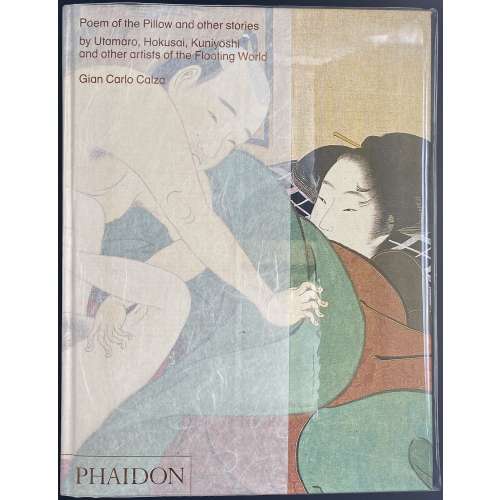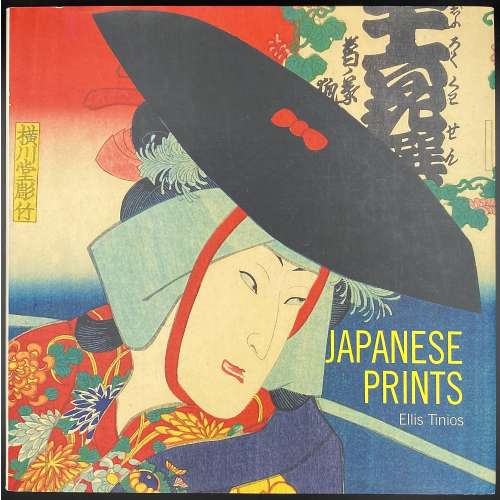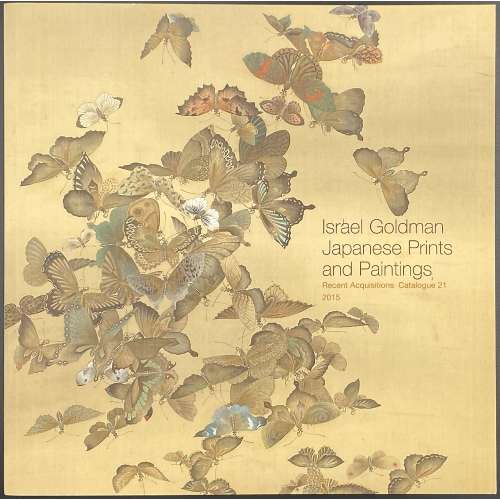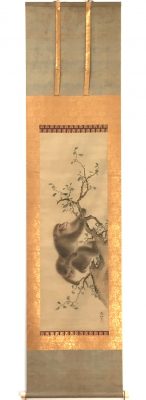|
"Poem of the Pillow and Other Stories examines the artistic developments of Japanese erotic art from the ukiyo-e period, dating from the mid-seventeenth century to the end of the nineteenth century. Known by the delicate euphemism of Shunga or 'spring images', these pictures were hugely popular and admired, and are today highly collectable works of art. This book illustrates major Shunga works from important ukiyo-e masters such as Utamaro, Hokusai, Harunobu, Kunisada, Kuniyoshi and many others. World-renowned scholar Gian Carlo Calza defines these fascinating erotic works in their social, historical and artistic context, providing a broad overview of a subject that is extremely nuanced and intriguing. Beautifully illustrated with over 300 images, including woodblock prints, scrolls and paintings, this book is a perfect introduction to ukiyo-e erotic art." |
-
 A pictorial album with almost no information (coffee-table book), hardcover, 28 x 21 x 4.8 cm, in pictorial paper boards, lettered all over, in transparent plastic dust jacket; pp.: [1-5] 6-463 [464 colophon], total 232 leaves, illustrated in colour throughout. Title-page: Poem of the Pillow and other stories | by Utamaro, Hokusai, Kuniyoshi | and other artists of the Floating World | Gian Carlo Calza | In collaboration with Stefania Piotti | {publisher’s device “Φ” in the bottom} || Contributors: Gian Carlo Calza (Italian, b. 1940); Stefania Piotti (Italian).
A pictorial album with almost no information (coffee-table book), hardcover, 28 x 21 x 4.8 cm, in pictorial paper boards, lettered all over, in transparent plastic dust jacket; pp.: [1-5] 6-463 [464 colophon], total 232 leaves, illustrated in colour throughout. Title-page: Poem of the Pillow and other stories | by Utamaro, Hokusai, Kuniyoshi | and other artists of the Floating World | Gian Carlo Calza | In collaboration with Stefania Piotti | {publisher’s device “Φ” in the bottom} || Contributors: Gian Carlo Calza (Italian, b. 1940); Stefania Piotti (Italian).
List of the artists: The Kanbun Master, Hishikawa Moronobu, Sugimura Jihei, Torii Kiyonobu I, Nishikawa Sukenobu, Miyagawa Chōshun, Okumura Masanobu, Tsukioka Settei, Suzuki Harunobu, Isoda Koryūsai, Katsukawa Shunshō, Katsukawa Shunchō, Kitao Masanobu, Torii Kiyonaga, Kitagawa Utamaro, Chōbunsai Eishi, Chōkyōsai Eiri, Katsushika Hokusai, Utagawa Toyokuni, Utagawa Kunisada, Kikugawa Eizan, Keisai Eisen, Utagawa Kuniyoshi. -
 Hardcover, 23.5 x 23.5 cm, publisher's navy cloth, gilt-stamped lettering to spine, pictorial DJ; pp.: [1-6] 7-143 [144 blank].
Hardcover, 23.5 x 23.5 cm, publisher's navy cloth, gilt-stamped lettering to spine, pictorial DJ; pp.: [1-6] 7-143 [144 blank].Japanese woodblock prints of the Edo period (1615-1868) were the products of a highly commercialised and competitive publishing industry. Their content was inspired by the vibrant popular culture that flourished in Edo (Tokyo). At any given time scores of publishers competed for the services of the leading artists of the day. Publishers and artists displayed tremendous ingenuity in finding ways to sustain demand for prints and to circumvent the restrictions placed on the industry through government censorship. Although Japanese prints have long been appreciated in the West for their graphic qualities, their content has not always been fully understood. This book draws on recent scholarship that makes possible a more subtle appreciation of the imagery encountered in the prints and how they would have been read when first made. Through stunning new photography of both well-known and rarely published works in the collection of the British Museum, including many recent acquisitions, the author explores how and why such prints were made, providing a fascinating introduction to a much-loved but little-understood art form.
-
 Softcover, pictorial wrappers, square 21 x 21 cm, 40 leaves, unpaginated, with illustrations in colour, 80 entries, with price list laid in; limited edition of 700 copies. Contributor: Israel Goldman In this collection:
Softcover, pictorial wrappers, square 21 x 21 cm, 40 leaves, unpaginated, with illustrations in colour, 80 entries, with price list laid in; limited edition of 700 copies. Contributor: Israel Goldman In this collection:
JPD-0008.2016: Mori Sosen. Ink and colour on silk.


